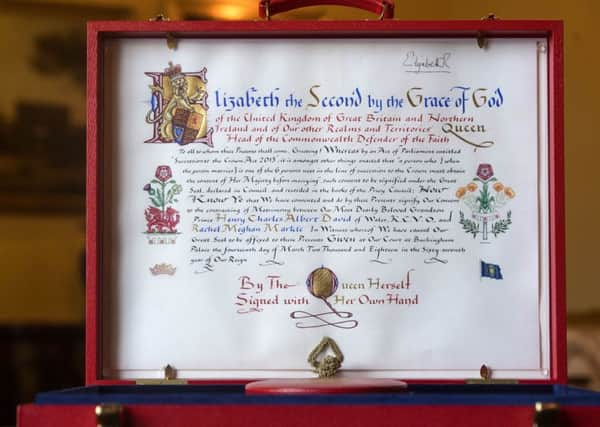Picture released of instrument of consent allowing Harry to wed


The Queen signed the Instrument of Consent in March - an elaborate notice of approval, transcribed in calligraphy, and issued under the Great Seal of the Realm.
The document states: “Now know ye that we have consented and do by these presents signify our consent to the contracting of matrimony between our most dearly beloved grandson Prince Henry Charles Albert David of Wales KCVO and Rachel Meghan Markle.”
Advertisement
Hide AdAdvertisement
Hide AdThe wording differs from the instrument signed to give consent to the marriage of the Duke and Duchess of Cambridge in 2011 when Kate was described as “our trusty and well-beloved” Catherine.
Harry took Meghan to meet the Queen for afternoon tea at Buckingham Palace in October last year to introduce her to the woman he wanted to wed.
Although the monarch was unlikely to have withheld her blessing, she would only have said “no” on the advice of the Prime Minister, whom she will have informed.
For hundreds of years, the Royal Marriages Act 1772 required descendants of George II to seek the sovereign’s consent before they wed, otherwise their marriages were deemed invalid.
Advertisement
Hide AdAdvertisement
Hide AdBut this law was repealed through the Succession to the Crown Act 2013, which came into effect in 2015 when all the Commonwealth countries, where the Queen is head of state, passed any necessary legislation.
The new Act still requires the first six people in the line of succession to obtain the Queen’s permission. Harry was fifth in line when he got engaged, but is now sixth with the birth of Prince Louis.
If Harry failed to get the Queen’s approval, he and his future descendants would be disqualified from succeeding to the Crown.
The Act was a radical shake-up of the rules of royal succession, removing male bias.
Advertisement
Hide AdAdvertisement
Hide AdThanks to the new law, a member of the royal family can now also marry a Roman Catholic and not lose their place in the line of succession. But a Roman Catholic royal still cannot be king or queen.
King George III, George II’s grandson, ordered the now repealed 1772 Act after his younger brother - the Duke of Cumberland - secretly married Lady Anne Horton, deemed to be a highly disreputable widow of a commoner.
Labour peer Lord Dubs once branded the law “the Dangerous Dogs Act of its day”, saying it was “passed in haste owing to George III’s chagrin that his relatives were getting married without consulting him”.
There is no requirement that royals marry someone of royal or aristocratic blood.